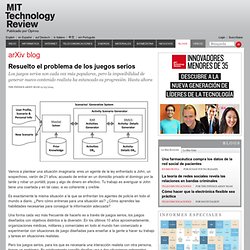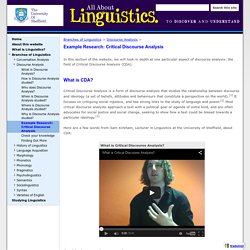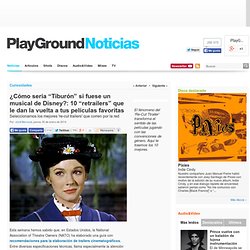

The best teachers and professors resemble parental figures: They provide their students with emotional mentorship. Resuelto el problema de los juegos serios. Vamos a plantear una situación imaginaria: eres un agente de la ley enfrentado a John, un sospechoso, varón de 21 años, acusado de entrar en un domicilio privado el domingo por la tarde y robar un portátil, joyas y algo de dinero en efectivo.

Tu trabajo es averiguar si John tiene una coartada y en tal caso, si es coherente y creíble. Es exactamente la misma situación a la que se enfrentan los agentes de policía en todo el mundo a diario. ¿Pero cómo entrenas para una situación así? ¿Cómo aprendes las habilidades necesarias para conseguir la información adecuada? Example Research: Critical Discourse Analysis - All About Linguistics. In this section of the website, we will look in depth at one particular aspect of discourse analysis: the field of Critical Discourse Analysis (CDA).

What is CDA? Critical Discourse Analysis is a form of discourse analysis that studies the relationship between discourse and ideology (a set of beliefs, attitudes and behaviours that constitute a perspective on the world).[1] It focuses on critiquing social injustice, and has strong links to the study of language and power.[1] Most critical discourse analysts approach a text with a political goal or agenda of some kind, and are often advocates for social justice and social change, seeking to show how a text could be biased towards a particular ideology.[1] Here are a few words from Sam Kirkham, Lecturer in Linguistics at the University of Sheffield, about CDA:
How To Teach Critical Thinking Using Bloom's Taxonomy. The various levels of Bloom’s Taxonomy are well known to teachers, students, and the rest of the education world at this point.

You need to slowly ascend the pyramid in order to effectively reach your goal(s). That’s great. But what happens when you try to apply other time-tested methodologies to the famous taxonomy? This happens. The visual guide you see below is from Flickr via Kris McElroy’s Pinterest board (she shares a lot of fabulous resources so check ‘em out!). Level One From the base knowledge level of the taxonomy you can see that you start with the usual ‘who’ ‘what’ ‘where’ and other questions.
Level Two You’re asked to re-tell and dive in a bit deeper into the topic you’re researching or discussing. Level Three How do you actually apply the skills you’re learning? Level Four Like a good scientist (this is close to the Scientific Method after all), we must analyze the results that are now coming forth. Level Five Time to remix and synthesize some new ideas or formulations. This Guy Has An Ingenious Solution For Avoiding Boredom On The Train.
Estos son los 63 anuncios que jugaron ayer la Super Bowl en el “césped” publicitario: ¿con cuál se queda? The 19 Best Super Bowl Ads of All Time. ¿Cómo sería “Tiburón” si fuese un musical de Disney?: 10 “retrailers” que le dan la vuelta a tus películas favoritas. Esta semana hemos sabido que, en Estados Unidos, la National Association of Theatre Owners (NATO) ha elaborado una guía con recomendaciones para la elaboración de trailers cinematográficos.

Entre diversas especificaciones técnicas, llama especialmente la atención la petición de que los trailers no duren más de dos minutos. Parece una medida razonable, sobre todo teniendo en cuenta que todos hemos tenido en alguna ocasión la sensación de haber visto una película completa con sólo ver su avance. El tráiler se inventó como herramienta de marketing para atraer espectadores, pero, en ocasiones, el efecto que logra es justo el contrario. Desde la irrupción del tráiler moderno a principios de los 60, el lenguaje de las promociones de películas se ha transformado por completo. Lo que empezó siendo un mero resumen de las escenas clave de la película acompañado de una frase rimbombante (“La mejor película del año!”
1. 2. 3. 12 tech trends higher education cannot afford to ignore. Higher education faces an onslaught of disruptive forces right now—and no one should be suprised to hear that news.

Burgeoning technologies such as MOOCs and mobile devices are disrupting institutional structures from the classroom and across entire campuses. As tech transforms these learning environments, universities must decide whether to resist the change or get out in front of it. To choose the latter option, however, we need to envision what universities of the future will look like—if they exist at all. Lev Gonick, the VP for information technology services and CIO at Case Western Reserve University and CEO of OneCommunity, isn’t afraid of gazing into the proverbial crystal ball.
In his keynote address Tuesday at the Campus Technology 2013 conference in Boston, Mass., Gonick laid out his vision for the future higher ed and campus IT. [Editor's Note: If you are interested in debating the vision he’s laid out, get in touch with Gonick on Twitter @levgonick.] Infographies / Life Expectancies of Superheroes #infographic #comic #transmedia.
Intertextuality and remix. You're Next - Official Trailer. Boston Marathon. Prak.ss13.